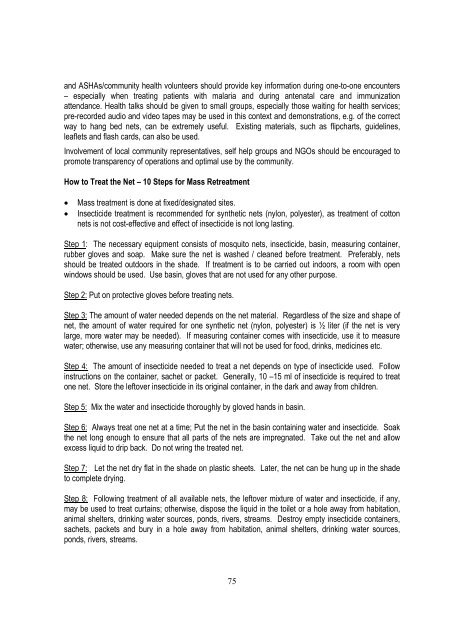training module for medical officers primary health centre - NVBDCP
training module for medical officers primary health centre - NVBDCP
training module for medical officers primary health centre - NVBDCP
- No tags were found...
You also want an ePaper? Increase the reach of your titles
YUMPU automatically turns print PDFs into web optimized ePapers that Google loves.
and ASHAs/community <strong>health</strong> volunteers should provide key in<strong>for</strong>mation during one-to-one encounters– especially when treating patients with malaria and during antenatal care and immunizationattendance. Health talks should be given to small groups, especially those waiting <strong>for</strong> <strong>health</strong> services;pre-recorded audio and video tapes may be used in this context and demonstrations, e.g. of the correctway to hang bed nets, can be extremely useful. Existing materials, such as flipcharts, guidelines,leaflets and flash cards, can also be used.Involvement of local community representatives, self help groups and NGOs should be encouraged topromote transparency of operations and optimal use by the community.How to Treat the Net – 10 Steps <strong>for</strong> Mass RetreatmentMass treatment is done at fixed/designated sites.Insecticide treatment is recommended <strong>for</strong> synthetic nets (nylon, polyester), as treatment of cottonnets is not cost-effective and effect of insecticide is not long lasting.Step 1: The necessary equipment consists of mosquito nets, insecticide, basin, measuring container,rubber gloves and soap. Make sure the net is washed / cleaned be<strong>for</strong>e treatment. Preferably, netsshould be treated outdoors in the shade. If treatment is to be carried out indoors, a room with openwindows should be used. Use basin, gloves that are not used <strong>for</strong> any other purpose.Step 2: Put on protective gloves be<strong>for</strong>e treating nets.Step 3: The amount of water needed depends on the net material. Regardless of the size and shape ofnet, the amount of water required <strong>for</strong> one synthetic net (nylon, polyester) is ½ liter (if the net is verylarge, more water may be needed). If measuring container comes with insecticide, use it to measurewater; otherwise, use any measuring container that will not be used <strong>for</strong> food, drinks, medicines etc.Step 4: The amount of insecticide needed to treat a net depends on type of insecticide used. Followinstructions on the container, sachet or packet. Generally, 10 –15 ml of insecticide is required to treatone net. Store the leftover insecticide in its original container, in the dark and away from children.Step 5: Mix the water and insecticide thoroughly by gloved hands in basin.Step 6: Always treat one net at a time; Put the net in the basin containing water and insecticide. Soakthe net long enough to ensure that all parts of the nets are impregnated. Take out the net and allowexcess liquid to drip back. Do not wring the treated net.Step 7: Let the net dry flat in the shade on plastic sheets. Later, the net can be hung up in the shadeto complete drying.Step 8: Following treatment of all available nets, the leftover mixture of water and insecticide, if any,may be used to treat curtains; otherwise, dispose the liquid in the toilet or a hole away from habitation,animal shelters, drinking water sources, ponds, rivers, streams. Destroy empty insecticide containers,sachets, packets and bury in a hole away from habitation, animal shelters, drinking water sources,ponds, rivers, streams.75
















